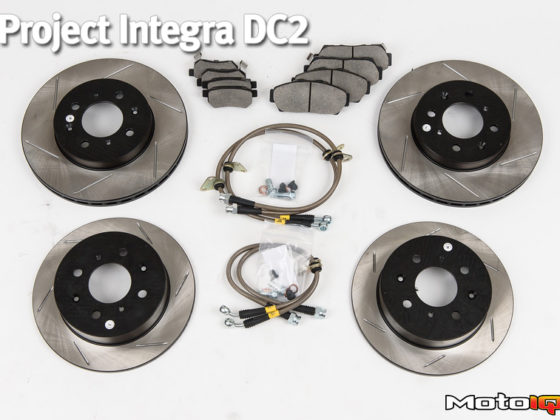,
 To make the S2000 more responsive, we ditched the stock flywheel and installed an XACT Prolite flywheel. ACT flywheels are one piece CNC machined from chromoly forgings. Chromoly is a steel alloy with a high chromium and molybdenum content. This makes a steel alloy with nearly twice the tensile strength per weight as regular high carbon steel.
To make the S2000 more responsive, we ditched the stock flywheel and installed an XACT Prolite flywheel. ACT flywheels are one piece CNC machined from chromoly forgings. Chromoly is a steel alloy with a high chromium and molybdenum content. This makes a steel alloy with nearly twice the tensile strength per weight as regular high carbon steel.Forging is also cool as it orients the metal's grain for best strength. It also works the metal and refines the grain which gives additional strength. The ACT Prolite flywheel is made of lightweight forged heat treated chromoly steel. It has a lot of milling to reduce weight. It is also resurfaceable.
 The back side of the ACT XACT Prolite flywheel is all hollowed out for less weight. The flywheel is one piece and lightening holes are milled out around the flywheel's perimeter to reduce its moment of inertia. This one piece construction is pretty cool! The starter ring gear teeth are induction hardened for longer life.
The back side of the ACT XACT Prolite flywheel is all hollowed out for less weight. The flywheel is one piece and lightening holes are milled out around the flywheel's perimeter to reduce its moment of inertia. This one piece construction is pretty cool! The starter ring gear teeth are induction hardened for longer life.The XACT flywheel for the AP1 S2000 weighs in at 8.1 lbs. The stock AP1 flywheel is 15 lbs and the AP2 flywheel is a whopping 21 lbs. Vince happens to have an AP1 so he is saving 7 lbs of rotating weight. As lightweight flywheels go, this is not a huge difference but it will be still enough to make a discernible difference in acceleration.
Lightweight flywheels are easier on the transmission syncros which allows faster up and down shifting and helps the syncros live longer. Happy syncros means grinding and miss shifting are less likely.
ACT flywheels are engineered using FEA stress analysis for best utilization of materials for strength and light weight. The flywheels are then burst tested and SFI certified, a very important item for your safety as well.
 The first step to accessing the clutch on an S2K is to drop the engine down on its crossmember. This makes getting to all of the bellhousing bolts easy and give you room to separate the transmission from the engine. You must first undo the steering shaft from the rack and to get to it you need to take off the air intake to reach it from the top.
The first step to accessing the clutch on an S2K is to drop the engine down on its crossmember. This makes getting to all of the bellhousing bolts easy and give you room to separate the transmission from the engine. You must first undo the steering shaft from the rack and to get to it you need to take off the air intake to reach it from the top. With the intake off and the alternator swung out of the way, Howard reaches down to undo the steering shaft from the rack. This is the easiest way to get to it.
With the intake off and the alternator swung out of the way, Howard reaches down to undo the steering shaft from the rack. This is the easiest way to get to it.  Here is the view from underneath. The S2K is pretty cool, the oil pan is ribbed for cooling as is the transmission case.
Here is the view from underneath. The S2K is pretty cool, the oil pan is ribbed for cooling as is the transmission case. Howard undoes the exhaust manifold from the exhaust system so the entire engine/trans can be dropped.
Howard undoes the exhaust manifold from the exhaust system so the entire engine/trans can be dropped.



6 comments
Are the other racing clutches for the Honda S2000 not streetable or not as desirable? I want to buy one of the most effective clutches for fast shifting and a somewhat small amount of power and torque. I strive on building a 300 horsepower all motor F20C through you guys in the near future, but I want to replace my clutch and flywheel now as it appears like it is about to go out. I don’t think I will need a clutch for massive amounts of power if I only plan of building a naturally aspirated motor. I would like to achieve my goal of 300 horsepower without stroking out the engine. I would prefer to raise the RPMs if necessary to achieve my goal. I was very intrigued by your video about the 320 horsepower K20 engine running on California 91 octane. From my research both engines are very similar in design. Currently my S2000 has a 12-point welded in roll cage with OMP racing bucket seats and 6-point harnesses. As funny as it may sound, I daily the car to the University of Arkansas and occasionally track it at Hallett in Oklahoma. However, I am originally from San Diego, California. Please tell me what you guys think when it comes to clutches and whether or not an engine build that I am describing interests you guys in the future. I reached out to you guys a few days ago on Instagram. My Instagram handle is Instaboone_ .
This clutch is fine at a good price point for that kind of use.
Thanks Mike! I noticed that ACT also makes a 4-puck and 6-puck clutch for the Honda S2000. Do you think a 6-puck clutch is too aggressive for both track and street use? I also noticed that when you guys replaced Vince’s clutch with the ACT clutch you guys opted for the OEM Honda bearings. Do you recommend that I do the same and stick with both the OEM Honda pilot and release bearings or should I go with ACT’s bearings? Is ACT your favorite brand of clutch for the Honda S2000? Thank you so much for helping me out. You guys are at the top of my list for rebuilding my engine for more naturally aspirated power!
Generally, I recommend using the least aggressive clutch that will do the job, it’s easier on the rest of the driveline.
Okay great! I will stay away from a puck clutch. Do you recommend that I do the same and stick with both the OEM Honda pilot and release bearings or should I go with ACT’s bearings?
Yes only do that when you need it. I am a big fan of OEM parts but the stuff that comes in the kit is fine.